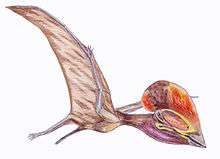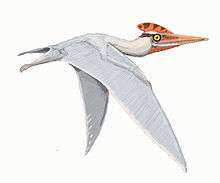Azhdarchoidea
| Azhdarchoids Temporal range: Late Jurassic - Late Cretaceous, 150–66 Ma | |
|---|---|
| | |
| Reconstructed skeleton of Quetzalcoatlus northropi | |
| Scientific classification | |
| Kingdom: | Animalia |
| Phylum: | Chordata |
| Class: | Reptilia |
| Order: | †Pterosauria |
| Suborder: | †Pterodactyloidea |
| Clade: | †Ornithocheiroidea |
| Clade: | †Azhdarchoidea Nesov, 1984 |
| Subgroups | |
| |
| Synonyms | |
|
Tapejaroidea | |
Azhdarchoidea is a group of pterosaurs within the suborder Pterodactyloidea.
Classification
Azhdarchoidea was given a phylogenetic definition by David Unwin in 2003. Unwin defined the group as the most recent common ancestor of Quetzalcoatlus and Tapejara, and all its descendants.[1]
There have been several competing views of azhdarchoid relationships. The first, presented by Felipe Pinheiro and colleagues in 2011, considered the tapejarids to be a monophyletic clade including the thalassodromids and chaoyangopterids.[2] The second, found by Naish & Martill 2006 as well as Lu et al. 2008, considered the traditional "tapejarids" to be a paraphyletic grade of primitive azhdarchoids. with true tapejarids most basal, and the thalassodromids and chaoyangopterids being successively more closely related to azhdarchids.[3] More recent and larger studies
All azhdarchoids which are part of the clade formed by Quetzalcoatlus and Tupuxuara are included in the group Neoazhdarchia ("new azhdarchids") as defined by Unwin in 2003. In 2003 Unwin also defined the clade Tapejaroidea, which he defined as the most recent common ancestor and all descendants of Tapejara, Quetzalcoatlus, and Dsungaripterus.[1]
There are competing theories of azhdarchoid phylogeny. Below is a cladogram showing the results of a phylogenetic analysis presented by Andres, Clark & Xu, 2014. This study found the a grouping of tapejarids at the base of the clade, with thalassodromids more closely related to azhdarchids and chaoyangopterids, as well as dsungaripterids.[4]
| Azhdarchoidea |
| ||||||||||||||||||||||||||||||
| |
The result of another analysis, by Vidovic and Martill, is shown below. They found tapejarids (including chaoyangopterines) to be the closest relatives of azhdarchids, followed by thalassodromids (represented by Tupuxuara) and then by dsungaripterids, making Azhdarchoidea itself a small subgroup of dsungaripteroids.[5]
| Dsungaripteroidea |
| |||||||||||||||||||||||||||||||||
| |
References
- 1 2 Unwin, D. M., (2003). "On the phylogeny and evolutionary history of pterosaurs." Pp. 139-190. in Buffetaut, E. & Mazin, J.-M., (eds.) (2003). Evolution and Palaeobiology of Pterosaurs. Geological Society of London, Special Publications 217, London, 1-347.
- ↑ Pinheiro, F.L., Fortier, D.C., Schultz, C.L., De Andrade, J.A.F.G. and Bantim, R.A.M. (in press). "New information on Tupandactylus imperator, with comments on the relationships of Tapejaridae (Pterosauria)." Acta Palaeontologica Polonica, in press, available online 03 Jan 2011. doi:10.4202/app.2010.0057
- ↑ Lü, J., Unwin, D.M., Xu, L., and Zhang, X. (2008). "A new azhdarchoid pterosaur from the Lower Cretaceous of China and its implications for pterosaur phylogeny and evolution." Naturwissenschaften, 95(9): 891-897. doi:10.1007/s00114-008-0397-5 PMID 18509616
- ↑ Andres, B.; Clark, J.; Xu, X. (2014). "The Earliest Pterodactyloid and the Origin of the Group". Current Biology. doi:10.1016/j.cub.2014.03.030.
- ↑ Vidovic, S. U.; Martill, D. M. (2014). "Pterodactylus scolopaciceps Meyer, 1860 (Pterosauria, Pterodactyloidea) from the Upper Jurassic of Bavaria, Germany: The Problem of Cryptic Pterosaur Taxa in Early Ontogeny". PLoS ONE. 9 (10): e110646. doi:10.1371/journal.pone.0110646.


